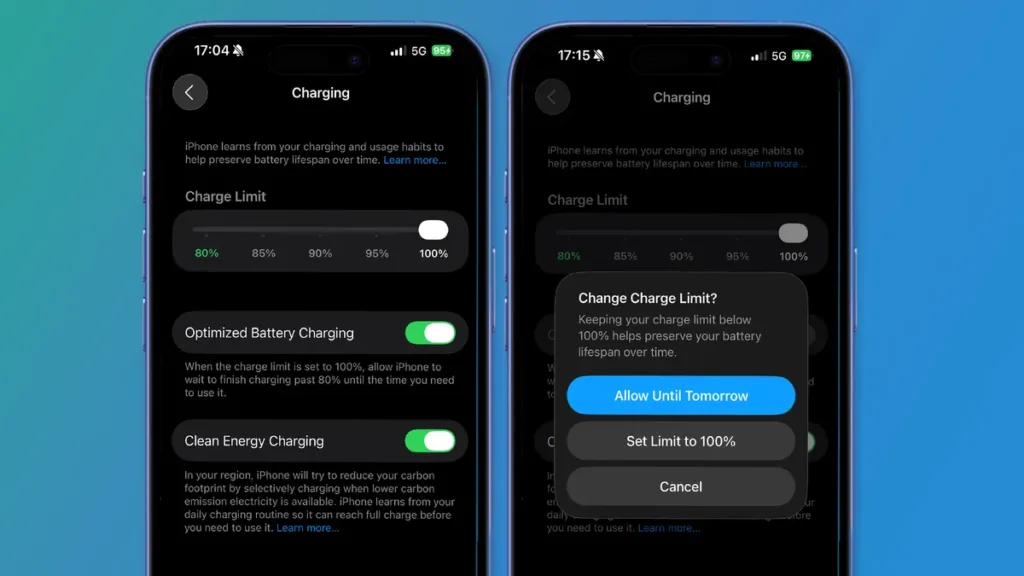Table of Contents
Many users ask if charging phones to 100% harms their batteries. The widespread belief is that reaching a full charge might overload or damage your battery, causing overheating or even fire. This idea originates from thinking about electricity like water pouring into a cup, where excess causes overflow. Occasional news stories of phones overheating seem to reinforce this fear.
Many smartphones now even send alerts about “optimized charging” or “scheduled charging,” which prompt users to suspect that topping up fully is damaging. Since charging produces heat, the notion that overcharging could “burn out” your phone feels reasonable. But is it accurate?
Check Out Our Article of 5 Apps You Should Use Instead of Spotify – The Best Spotify Alternatives Tested Published on October 1st, 2025 SquaredTech
In reality, charging to 100% is generally safe for modern phones. The misconception largely stems from older battery types like nickel-cadmium, which suffered from “memory effects” if fully charged repeatedly. Over time, these batteries lost capacity because they “remembered” smaller charge levels. While such issues shaped earlier advice, lithium-ion batteries—the standard today—behave differently and include built-in safeguards to prevent overcharging.
Understanding Lithium-Ion Battery Charging
To see why stopping at 100% is often unnecessary, it helps to know how lithium-ion batteries charge and discharge. Batteries hold lithium ions between two electrodes, called the cathode and anode. Charging moves lithium ions from the cathode to the anode, storing energy. When using the phone, lithium ions move back to the cathode, releasing this energy as electrical power.
Kent Griffith, a chemistry professor, explains that when your phone shows 100% charge, it hasn’t actually removed all lithium ions from the cathode. Instead, it reaches a “state of charge” that might correspond to storing about 60% of lithium ions in the anode, leaving a buffer zone to protect the battery. Charging to 90% only stores slightly fewer ions but provides added longevity because it reduces stress on the battery.
This buffer prevents true overcharging, which could otherwise damage the lithium-ion cells. So even fully charged phones avoid chemical overloads or dangerous excesses by design.
Modern Best Practices for Battery Charging

Experts like Associate Professor Ritesh Chugh from Central Queensland University emphasize that lithium-ion batteries perform best when kept between roughly 20% and 80% charge. Staying within this range minimizes the long-term wear caused by voltage stress and heat. Charging to 100% occasionally is fine and won’t instantly harm your battery, but consistently maintaining full charge for extended periods can accelerate battery degradation.
Smartphone manufacturers are aware of this and include features like “optimized battery charging.” For example, Apple’s iPhones learn your daily charging routine and delay charging past 80% until shortly before use. These protections strike a balance—allowing convenience without unduly sacrificing battery health.
Kent Griffith personally charges to 100% daily for convenience and acknowledges that while it could speed wear marginally, the trade-off is worth it. His battery replacement hasn’t been necessary even after three years of this approach. Griffith also stresses the importance of avoiding heat and using quality chargers to prevent degradation or safety hazards.
Key Tips to Extend Battery Life
- Avoid letting your phone battery drop to 0%, which can cause irreversible damage through deep discharge.
- Charge regularly and keep the battery level ideally between 20% and 80% to reduce stress.
- Avoid charging in hot environments or placing your phone under pillows or in direct sunlight during charging.
- Use reputable, high-quality chargers to ensure stable current flow and prevent battery damage.
- Take advantage of built-in smartphone features that optimize charging to avoid unnecessary full charges.
Conclusion
The myth that charging your phone battery to 100% will ruin it is largely outdated and based on older battery technologies. Modern lithium-ion phones have built-in safeguards to prevent true overcharging and damage. Charging to 100% occasionally is not harmful, but consistently maintaining a full charge can wear batteries faster over time. For the best balance, keep your battery between 20% and 80% where possible and avoid heat to guard its lifespan.
SquaredTech recognizes the importance of clear, fact-based advice for our readers. Understanding how lithium-ion batteries work and following practical charging tips can help you get the most from your phone’s battery life without giving in to unfounded fears.
Charging smart is key, but also remember convenience plays a role too. Sometimes a full charge makes sense for your day, and that’s perfectly okay. Keep informed with SquaredTech for more technology insight and guidance.
Thank you for trusting SquaredTech to help you power your devices wisely. We stay committed to bringing you clear, practical advice that demystifies technology and helps you live smarter.
Stay Updated: Tech News


